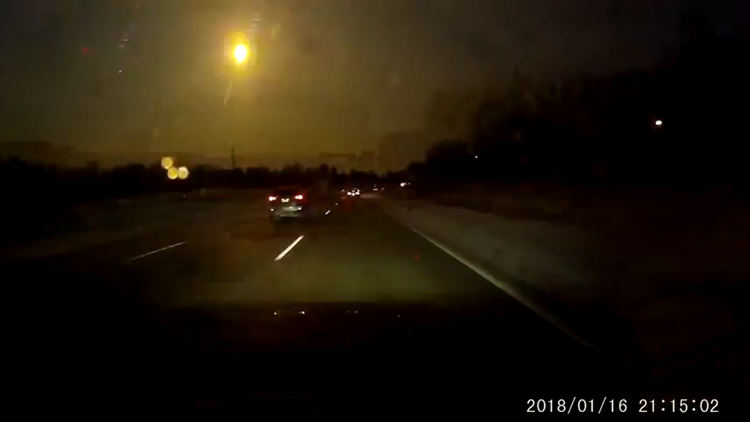A spectacular meteor flash across southern Michigan skies in January is the gift that keeps on giving for scientists.
The Jan. 17 meteor exploded in the atmosphere near Livingston County's Hamburg Township, showering small fragments on the snowy ground below. Only rarely do such large meteor events occur in a heavily populated area, with tens of thousands witnessing it light up the night sky, breaking apart as it fell toward Earth, or hearing its sonic boom as it traveled faster than the speed of sound.
But the event was also unusual because it happened within the recording capability of a lot of different scientific instruments.
Longway Planetarium Executive Director Todd Slisher shows off his meteorite find from the meteor that arrived Jan. 16, 2018 in metro Detroit. (Photo: Longway Planetarium)
In a research paper slated for publication later this month, scientists at the Scripps Institution of Oceanography in San Diego who study atmospheric infrasound — sound waves too low-frequency for the human ear to detect — are teaming with seismologists from the University of Michigan who typically measure earthquakes to show their combined data revealed even more about Michigan's great celestial event of 2018.
Their findings hold promise for helping researchers understand how often bolides — meteors that explode in the atmosphere — occur outside the view of witnesses. This in turn could help improve understanding of the threats facing our planet from "near-Earth objects" of all sizes.
"It's been useful. It's been really interesting to us," said Michael Hedlin, head of the Laboratory for Atmospheric Acoustics at Scripps.
"This event kind of fell into our laps; we were studying something else."
Hedlin and his team were researching atmospheric gravity waves, utilizing an array of 159 infrasound sensors across the eastern and central U.S. that are constantly recording low-frequency sound.
When the meteor flashed across the sky, making its sonic boom, Hedlin knew he'd have a treasure trove of infrasound data related to it. He found it from instruments as far away as nearly 750 miles, near the U.S. East Coast.
At about the same time, at the University of Michigan's Department of Earth and Environmental Sciences, seismologist Jeroen Ritsema was thinking along the same lines.
"This is really the first time I've studied a meteor — I usually study earthquakes," he said.
Screen grab of footage of a suspected meteor. (Photo: Chris Laine)
But knowing the exact time of the meteor's burst from satellite and cell phone camera recordings, Ritsema knew he could review constantly recorded seismic data from the region to try to find it.
Seismometers are so sensitive, recording the smallest ground movements, that Ritsema believed even an explosion high up in the atmosphere would be detectable. Sure enough, the meteor's blast was recorded at seven seismometer stations in Michigan, Ohio and Ontario.
"It's certainly the smallest signal I've ever looked at," Ritsema said. "It helps to have a very precise time of the burst, and an initial location."
As Ritsema was making that discovery, Hedlin called, and suggested they combine their separate disciplines into one research project.
"We could locate it (seismically) at exactly the same location where the infrasound was placing it," Ritsema said.
Among the things they confirmed: the location the bolide came into the atmosphere over Michigan, that it came in at a steep trajectory, that it exploded under atmospheric pressures and speed friction at about 23 kilometers — just over 14 miles — up in the sky, and the time of the blast. Comparing their findings with the satellite and recorded video data, it all lined up.
Meteors the size of Michigan's — about 2 yards in diameter — are far more common than, say, the 22-yard diameter meteor that exploded over Chelyabinsk, Russia, on Feb. 15, 2013, injuring nearly 1,500 people, primarily from shattering windows.
Screen grab of YouTube video courtesy of Mike Austin shows suspected meteor. (Photo: Mike Austin)
Thousands of meteors the size of Michigan's or larger may fall across the globe in a year, the vast majority away from large numbers of witnesses or sophisticated scientific recording instruments.
"We're trying to get a better idea of how common these are," Hedlin said. "How useful is our network for picking these things up?"
Infrasound microphones record 24 hours a day, seven days a week, and are very sensitive, he said. Buried in all that collected data may be new knowledge about bolide meteorite events, and more.
"They probably have a lot of secrets we haven't found yet," Hedlin said. "I want to find out."
Contact Keith Matheny: 313-222-5021 or kmatheny@freepress.com. Follow on Twitter @keithmatheny.
►Make it easy to keep up to date with more stories like this. Download the 13 ON YOUR SIDE app now.
Have a news tip? Email news@wzzm13.com, visit our Facebook page or Twitter.



